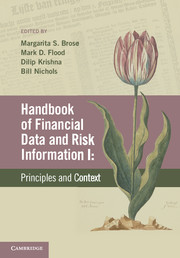Book contents
- Frontmatter
- Contents
- List of contributors
- Preface
- VOLUME I: PRINCIPLES AND CONTEXT
- PART I RISK MANAGEMENT CONTEXT FOR FINANCIAL DATA
- 1 A brief history of financial risk and information
- 2 Risk management
- 3 Portfolio risk monitoring
- 4 Frameworks for systemic risk monitoring
- 5 Data-driven regulation and financial reform: one perspective from industry on the financial crisis
- PART II REQUIREMENTS AND SOURCES FOR FINANCIAL RISK MANAGEMENT
- PART III REGULATORY DATA
- Index – Volume I
- References
2 - Risk management
from PART I - RISK MANAGEMENT CONTEXT FOR FINANCIAL DATA
- Frontmatter
- Contents
- List of contributors
- Preface
- VOLUME I: PRINCIPLES AND CONTEXT
- PART I RISK MANAGEMENT CONTEXT FOR FINANCIAL DATA
- 1 A brief history of financial risk and information
- 2 Risk management
- 3 Portfolio risk monitoring
- 4 Frameworks for systemic risk monitoring
- 5 Data-driven regulation and financial reform: one perspective from industry on the financial crisis
- PART II REQUIREMENTS AND SOURCES FOR FINANCIAL RISK MANAGEMENT
- PART III REGULATORY DATA
- Index – Volume I
- References
Summary
What is risk management?
Financial institutions (FIs) that deal in commercial banking or trading activities are exposed to a variety of risks. In fact, risk-taking goes to the core of their business. When a bank lends money to a borrower, it is taking the risk that the borrower may not be able to pay back the loan. The profits it earns on the loans can be considered to incorporate the price of accepting this risk. Likewise when a trading firm buys (or sells) securities in the marketplace, it is accepting the risk that the price of the security will go down (or up) resulting in a loss. Global FIs are often exposed to many risks on a truly massive scale. Complicating the picture for these large FIs is that some risks counteract others. In fact, it is commonplace for firms to accept new risks as a way to counter existing risks, a process called “hedging.” It is therefore critical for banks to control this complex patchwork of risks across the firm in a measured and organized fashion. Risk management is the discipline that FIs use to do this.
The first step in managing risk is to be able to measure it – perhaps the most significant achievement of modern risk management is the development of techniques to quantify risk in terms of a potential monetary loss. Risk can be measured in statistical terms as the loss that would be experienced with a particular level of confidence.
Information
- Type
- Chapter
- Information
- Handbook of Financial Data and Risk Information IPrinciples and Context, pp. 33 - 74Publisher: Cambridge University PressPrint publication year: 2014
References
Accessibility standard: Unknown
Why this information is here
This section outlines the accessibility features of this content - including support for screen readers, full keyboard navigation and high-contrast display options. This may not be relevant for you.Accessibility Information
- 3
- Cited by
